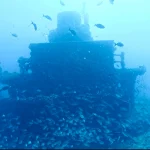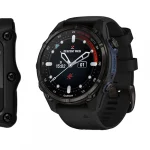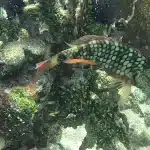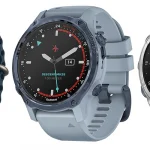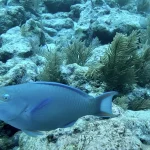Table of Contents
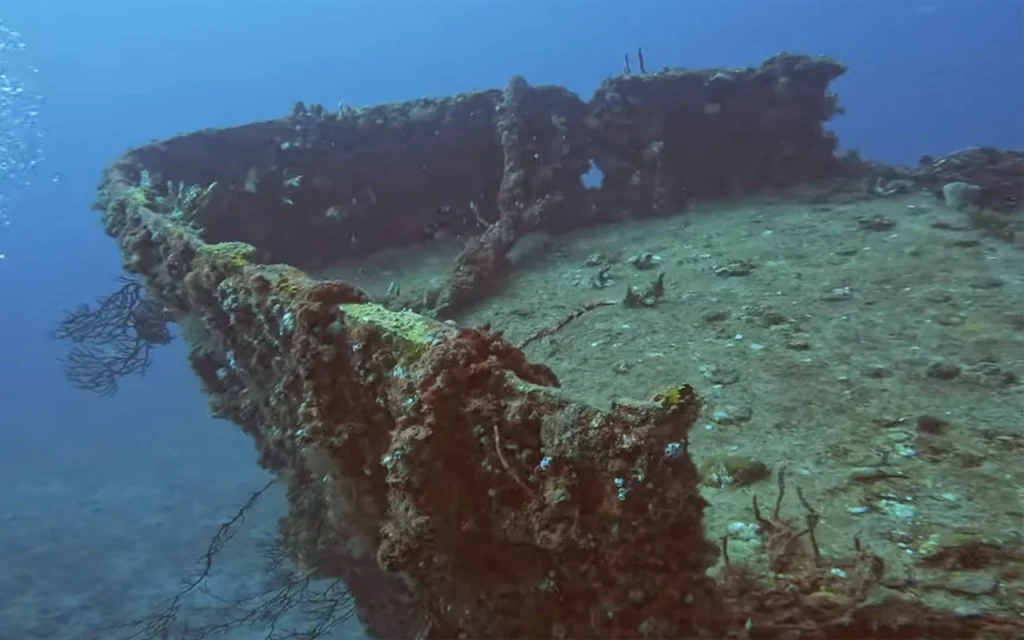
The wreck’s proximity to natural reefs allows for a constant exchange of marine life, enhancing its biodiversity. The hard substrate provided by the wreck creates shelter and refuges for species at various life stages, from larvae to adults.
Article at a Glance
• Location: 0.79 nautical miles offshore from Pompano Beach, Florida at coordinates 26° 18.121′ N, 80° 03.729′ W
• Depth: The wreck sits upright with a slight list to port, ranging from 50 feet at the top to 70 feet at the sandy bottom
• History: Originally a Coast Guard cutter named Nemesis, later served as a floating restaurant before being intentionally sunk as an artificial reef in 1991
• Size: 165 feet long and 25 feet wide, providing ample exploration opportunities for divers
• Marine Life: Home to various fish species, including large Goliath Groupers often found in the wheelhouse
• Dive Experience: Suitable for all skill levels, offering both exterior exploration and wreck penetration for properly trained divers
• Nearby Attractions: Part of a “Wreck Trek” with other nearby wrecks like the Berry Patch Tug, allowing for multi-wreck dives for experienced divers
Shipwreck Location Coordinates and Depth
Depth
Location Coordinates
The wreck’s precise coordinates are:
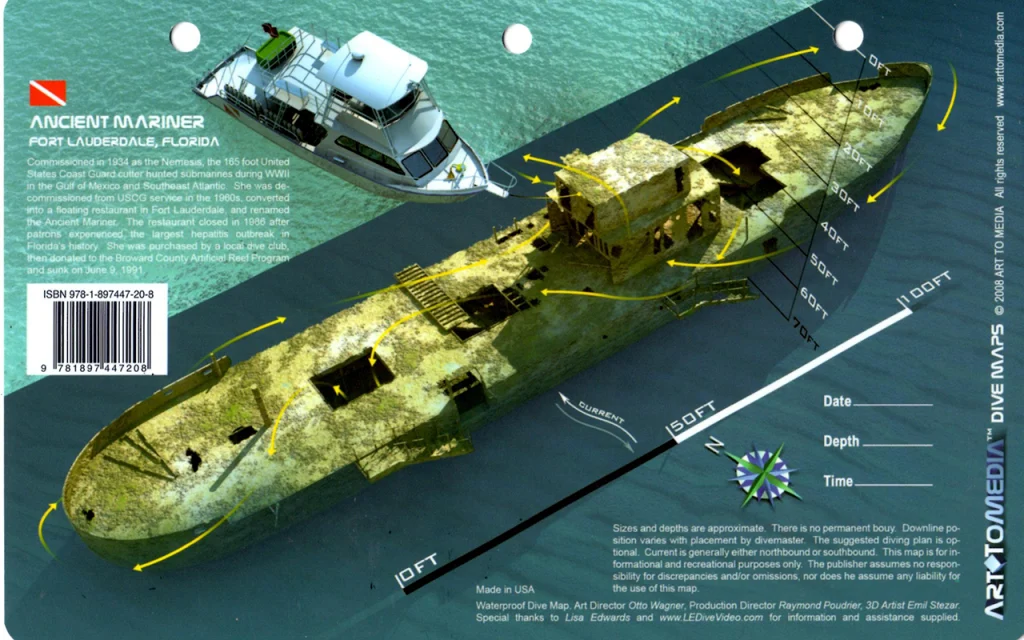
What Do Scuba Divers Say About This Ship
Dive Site Characteristics
- The wreck sits upright with a slight list to port at depths between 50-70 feet, making it accessible for divers of various skill levels.
- It’s a large wreck at 165 feet long and 25 feet wide, providing plenty to explore.
- Visibility is often good, with reports of 30-40 feet of visibility on good days.
Marine Life
- The wreck is covered in colorful marine growth and attracts abundant sea life.
- Divers report seeing schools of reef fish, hogfish, and even large species like Goliath Groupers.
- The close proximity to natural reefs allows fish to move back and forth, enhancing biodiversity.
Exploration Opportunities
- There are multiple open spaces and entry points for wreck penetration, appealing to more experienced divers.
- The forward section is noted as the best area for penetration.
- The wheelhouse is a popular spot, often housing a large Goliath Grouper.
Overall Experience
- Divers describe it as a great wreck dive site with lots to see and explore.
- Its history as a Coast Guard cutter and former restaurant adds intrigue for many divers.
- The presence of nearby wrecks like the Berry Patch Tug allows for multi-wreck dives for those with good air consumption and navigation skills.
What Kind of Marine Life Can Be Found on The Ship
Fish Species
- Large schools of reef fish
- Hogfish
- Goliath Grouper (often found in the wheelhouse)
- Various species that migrate between nearby wrecks and reefs
Invertebrates
- Lobsters
- Crabs
- Moray eels
- Sea urchins
- Queen scallops
- Ascidians (sea squirts)
- Sea stars
Sessile Organisms
- Colorful marine growth covering the wreck
- Barnacles
- Tubeworms
- Hydroids
- Plumose anemones
- Dead man’s fingers (a type of soft coral)
- Various species of sponges
- Algae
Key Information
| Feature | Details |
|---|---|
| Construction Details | Built in 1934 as a Prohibition Runner; launched as U.S.C.G.C. Nemesis. |
| Military Service | Served in WWII as a submarine chaser; engaged in depth charge attacks. |
| Rescue Operations | Involved in notable rescues of survivors from torpedoed vessels. |
| Transition to Civilian | Became Fort Lauderdale’s first floating restaurant after decommissioning in 1964. |
| Culinary Challenges | Faced operational setbacks, including a hepatitis outbreak and sinking at dock. |
| Artificial Reef Status | Intentionally sunk in 1991 as part of Broward County’s artificial reef program. |
| Diving Opportunities | Offers wreck penetration for training; part of a multi-wreck dive site with nearby attractions. |
What Makes The Ancient Mariner a Unique Diving Experience
Historical Significance
The Ancient Mariner has a rich and varied history that adds intrigue to the dive:
- Originally built as a Coast Guard cutter in 1934
- Served as a submarine chaser and convoy escort during World War II
- Later became Fort Lauderdale’s first floating restaurant
- Experienced a series of mishaps, including sinking at the dock and a hepatitis outbreak
- Finally intentionally sunk as an artificial reef in 1991
This colorful past gives divers a sense of exploring a piece of maritime history.
Wreck Characteristics
The physical attributes of the wreck make it an interesting dive site:
- Large size: 165 feet long and 25 feet wide
- Upright position with a slight list to port
- Multiple open spaces and entry points for wreck penetration
- Collapsed aft deck, with the best penetration opportunities in the forward section
- Depth range of 50-70 feet, making it accessible to various skill levels
Marine Life
The Ancient Mariner has developed into a thriving artificial reef:
- Covered in colorful marine growth
- Home to large schools of reef fish
- Often houses a large Goliath Grouper in the wheelhouse
- Close proximity to natural reefs allows for diverse marine life
Multi-Wreck Dive Opportunities
The Ancient Mariner is part of a larger wreck system:
- Located near other wrecks like the Berry Patch Tug (150 feet away) and the Quallman Barge
- Allows experienced divers to potentially visit multiple wrecks in one dive
Dive Planning Flexibility
The site offers options for different types of dives:
- Can be combined with reef dives in the area
- Suitable for both beginner and more experienced divers
- Opportunities for wreck penetration for appropriately trained divers
How Does The Ancient Mariner Compare to Other Shipwrecks in Florida
Size and Accessibility
- At 165 feet long, the Ancient Mariner is a substantial wreck, larger than many others in the area.
- Its depth range of 50-70 feet makes it accessible to divers of various skill levels, unlike deeper wrecks that require advanced training.
Historical Significance
- The ship has a rich history, serving as a Coast Guard cutter, WWII submarine chaser, and later as a floating restaurant.
- This varied background sets it apart from purpose-sunk vessels or accidental shipwrecks.
Wreck Condition
- The Ancient Mariner sits upright with a slight list to port, providing an easily navigable dive site.
- While some degradation has occurred over time, much of the structure remains intact, offering both exterior and interior exploration opportunities.
Marine Life
- The wreck’s proximity to natural reefs allows for a diverse ecosystem, with marine life moving between the wreck and nearby reefs.
- The presence of large species like Goliath Groupers is a notable feature.
Multi-Wreck Experience
- The Ancient Mariner is part of a “Wreck Trek,” with other wrecks like the Berry Patch Tug nearby.
- This allows experienced divers to potentially visit multiple wrecks in one dive, a feature not common to all Florida shipwrecks.
Artificial Reef Program
- As part of Broward County’s artificial reef program, the Ancient Mariner represents a deliberate effort to create marine habitats, unlike accidental wrecks.
What is The Full History of This Ship
Early Years as a Coast Guard Cutter
- Launched on July 7, 1934, by the Marietta Manufacturing Company in Point Pleasant, West Virginia.
- Commissioned on October 10, 1934, as the U.S.C.G.C. Nemesis (WPC-111).
- Originally built to be a Prohibition Runner, but Prohibition ended a year before its completion.
World War II Service
- Served during World War II on the Gulf Sea Frontier.
- Used as a submarine chaser and convoy escort.
- Engaged in six separate depth charge attacks against enemy U-boats in the Atlantic and Gulf of Mexico between January 24 and August 17, 1942.
- Rescued survivors from torpedoed ships:
- Finished the war on escort duty between Key West and New York.
Post-War Service
- Patrolled between Florida and Cuba, enforcing U.S. law, conducting search and rescue operations, and aiding Cuban refugees.
- Decommissioned on November 20, 1964.
Civilian Life
- Sold to Auto Marine Engineering, Inc. of Miami on February 9, 1966.
- In 1979, investors purchased the vessel and remodeled it to resemble a three-deck African steamer.
- Renamed “Livingston’s Landing” and became Fort Lauderdale’s first floating restaurant.
- Closed in 1981 and renamed “Ancient Mariner”.
- On April 28, 1981, it sank at the dock before the new restaurant could open.
- Re-floated and reopened as a restaurant.
- In 1986, more than 100 patrons contracted hepatitis after dining aboard, leading to bankruptcy.
- Reopened under several names, but none lasted long.
Final Chapter
- Purchased by the South Florida Divers Club of Hollywood for $6,000.
- Donated to Broward County’s artificial reef program.
- On June 9, 1991, intentionally sunk as an artificial reef off Deerfield Beach.
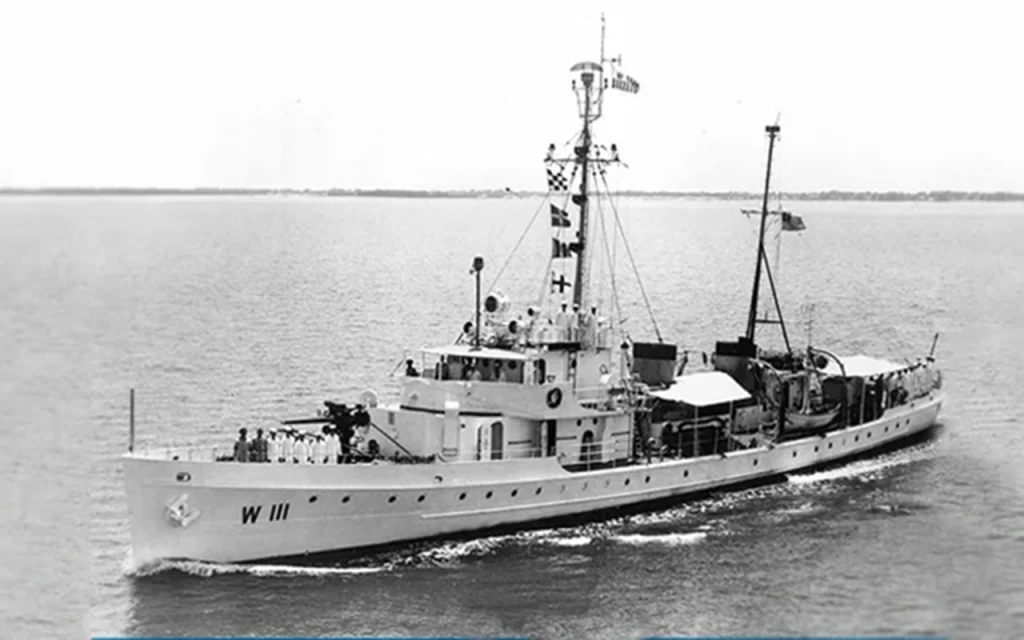
What Historical Features Can Still Be Identified on The Ancient Mariner Wreck
- Overall Structure: The ship remains upright on the seafloor with a slight list to port, allowing divers to recognize its general shape and orientation.
- Size: At 165 feet long and 25 feet wide, the wreck’s substantial size is still apparent, giving divers a sense of its original dimensions as a Coast Guard cutter.
- Deck Areas: While some of the top deck was reportedly washed away by storms, divers can still explore various deck areas.
- Penetration Points: The wreck has multiple open spaces and entry points that allow for wreck penetration, suggesting preserved internal structures.
- Wheelhouse: This is often mentioned as a focal point for divers, indicating it’s still a recognizable feature of the wreck.
- Bow Section: The bow is intact enough to be used as a reference point for locating nearby wrecks.
- Hull: The hull is described as being full of marine life, suggesting that while degraded, it’s still a substantial part of the wreck.
- Degraded Elements: The illustration mentioned shows that the wreck has degraded over time, which in itself is a historical feature showing the ship’s age and time underwater.
What Safety Measures Are in Place for Divers Visiting the Ancient Mariner
Dive Site Characteristics
- The wreck sits at a relatively shallow depth, with the top at around 50 feet and the bottom at 70 feet, making it accessible for various skill levels.
- Its upright position with a slight list provides a stable and predictable environment for divers.
Dive Planning and Supervision
- Most dive operators require divers to have at least an Open Water certification.
- Dive briefings are typically provided before the dive, covering important safety information and site details.
- Guided dives are often available, especially for less experienced divers.
Equipment Requirements
Divers are usually required to bring or rent:
- Audible and visual surface signaling devices (e.g. whistles, safety sausages)
- Dive lights for better visibility inside the wreck
- Emergency mirrors for signaling
Wreck-Specific Safety
- Multiple entry and exit points allow for easier navigation and emergency exits.
- The wreck’s condition is regularly monitored, and unsafe areas are typically marked or closed off.
Environmental Considerations
- Dive operators monitor weather and sea conditions, canceling or modifying dives if conditions are unfavorable.
- Information about currents and visibility is usually provided to divers before the dive.
Emergency Preparedness
- Dive boats are equipped with first aid kits and oxygen.
- Many operators require or strongly recommend divers have dive insurance (e.g. DAN insurance).
Diver Responsibility
- Divers are expected to dive within their certification limits and personal comfort levels.
- Buddy system is typically enforced for added safety.
Dive Shops That Provide Diving Trips to This Shipwreck
- Aquatic Ventures
- Offers scheduled trips to the Ancient Mariner wreck
- Departs from Pompano Beach
- Force-E Scuba Divers
- Includes the Ancient Mariner in their boat dive sites
- Located in Pompano Beach
- South Florida Diving Headquarters
- Offers trips to various wrecks including the Ancient Mariner
- Based in Pompano Beach
- SCUBA Dive It
- Provides dive trips to the Ancient Mariner as part of their offerings
- Offers a two-dive package including the wreck and a reef dive

